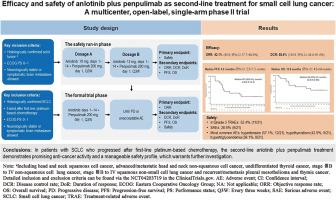安罗替尼加培罗单抗作为小细胞肺癌二线治疗的有效性和安全性:多中心、开放标签、单臂II期试验
IF 2.8
引用次数: 0
摘要
背景目前,小细胞肺癌(SCLC)二线治疗急需使用程序性细胞死亡蛋白-1(PD-1)单克隆抗体的新治疗策略。本研究旨在评估安罗替尼联合戊普利单抗作为一线铂类化疗后病情进展的SCLC患者二线治疗的有效性和安全性。在安罗替尼(10/12 毫克,第 1-14 天,quaque die [QD])+ Penpulimab(200 毫克,第 1 天,静脉注射[IV])的 21 天周期内,患者接受安罗替尼(12 毫克,第 1-14 天,quaque die [QD])+ Penpulimab(200 毫克,第 1 天,静脉注射[IV])的 21 天周期治疗。安全运行阶段的主要终点是安全性。结果从2020年4月28日到2020年11月24日,共有来自11家医院的21名患者入组,其中安全运行阶段2人,正式试验阶段19人。在正式试验阶段,ORR 为 42.1%(8/19;95% 置信区间 [CI]:17.7-66.6%)。中位无进展生存期为4.8个月(95% CI:2.9-11.3个月),中位总生存期为13.0个月(95% CI:4.6-不适用[NA]个月)。≥3级治疗相关不良事件(TRAEs)发生率为52.4%(11/21),治疗相关严重不良事件(AEs)发生率为28.6%(6/21)。有两例与不良反应相关的死亡病例。最常见的不良反应是高血压(57.1%,12/21)、甲状腺功能减退(42.9%,9/21)和高甘油三酯血症(38.1%,8/21)。结论在一线铂类化疗后病情进展的SCLC患者中,二线安罗替尼加培罗单抗治疗显示出良好的抗癌活性和可控的安全性,值得进一步研究。试验登记号:NCT04203719,https://clinicaltrials.gov/。本文章由计算机程序翻译,如有差异,请以英文原文为准。

Efficacy and safety of anlotinib plus penpulimab as second-line treatment for small cell lung cancer: A multicenter, open-label, single-arm phase II trial
Background
Currently, the need for new therapeutic strategies involving programmed cell death protein-1 (PD-1) monoclonal antibodies in the second-line setting of small cell lung cancer (SCLC) is urgent. This study aimed to evaluate the efficacy and safety of anlotinib plus penpulimab as a second-line treatment for patients with SCLC who progressed after first-line platinum-based chemotherapy.
Methods
This study included the patients from Cohort 4 of a single-arm, open-label, multicenter, phase II clinical trial. A safety run-in phase was performed under anlotinib (10/12 mg quaque die [QD], days 1–14) plus penpulimab (200 mg intravenously [IV], day 1) in a 21-day cycle, followed by the formal trial in which the patients received anlotinib (12 mg QD, days 1–14) plus penpulimab (200 mg IV, day 1) in a 21-day cycle. The primary endpoint of the safety run-in phase was safety. The primary endpoint of the formal trial phase was the objective response rate (ORR).
Results
From April 28, 2020, to November 24, 2020, 21 patients were enrolled from 11 hospitals, including 2 in the safety run-in phase and 19 in the formal trial phase. In the formal trial phase, the ORR was 42.1% (8/19; 95% confidence interval [CI]: 17.7–66.6%). The median progression-free survival was 4.8 months (95% CI: 2.9–11.3 months), and the median overall survival was 13.0 months (95% CI: 4.6–not applicable [NA] months). The incidence of ≥grade 3 treatment-related adverse events (TRAEs) was 52.4% (11/21), and the incidence of treatment-related serious adverse events (AEs) was 28.6% (6/21). Two AE-related deaths occurred. The most common AEs were hypertension (57.1%, 12/21), hypothyroidism (42.9%, 9/21), and hypertriglyceridemia (38.1%, 8/21).
Conclusions
In patients with SCLC who progressed after first-line platinum-based chemotherapy, the second-line anlotinib plus penpulimab treatment demonstrates promising anti-cancer activity and a manageable safety profile, which warrants further investigation.
Trial registration
No. NCT04203719, https://clinicaltrials.gov/.
求助全文
通过发布文献求助,成功后即可免费获取论文全文。
去求助
来源期刊

Cancer pathogenesis and therapy
Surgery, Radiology and Imaging, Cancer Research, Oncology
CiteScore
0.80
自引率
0.00%
发文量
0
审稿时长
54 days
 求助内容:
求助内容: 应助结果提醒方式:
应助结果提醒方式:


